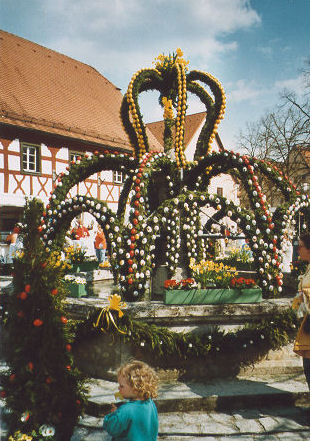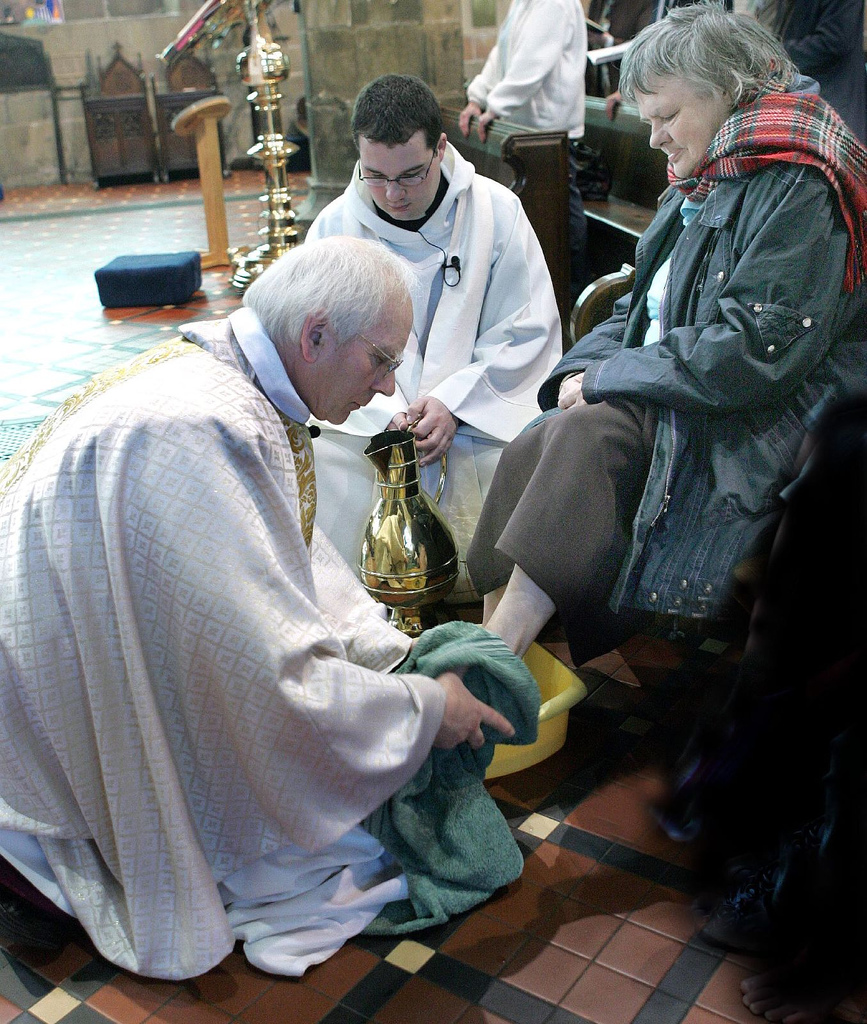|
Osterbrunnen
The Osterbrunnen (Easter Well or Easter Fountain) is a German tradition of decorating public wells or fountains with Easter eggs for Easter. It began in the early 20th century in the Franconian Switzerland region of Upper Franconia but has spread to other regions. The decoration is usually kept from Good Friday until two weeks after Easter. History Decorating a well for Easter honours water, essential for life, and Easter, the feast of renewed life. In addition to eggs (now often artificial, to guard against vandalism), paper ribbons called "Pensala" and garlands of evergreens are woven around well-heads or formed into crowns over them. In several locations flowers are also used. Franconian Switzerland (), so called for its rugged rock outcroppings, lies in the region of Upper Franconia in northern Bavaria. The tradition of Osterbrunnen began there in the early 20th century. The Osterbrunnen in Aufseß is said to have been first decorated around 1909; that in the village of En ... [...More Info...] [...Related Items...] OR: [Wikipedia] [Google] [Baidu] |
Franconian Switzerland
Franconian Switzerland (, ) is an upland in Upper Franconia, Bavaria, Germany and a popular tourist retreat. Located between the River Pegnitz in the east and the south, the River Regnitz in the west and the River Main in the north, its relief, which reaches 600 metres in height, forms the northern part of the Franconian Jura (''Frankenjura''). Like several other mountainous landscapes in the German-speaking lands, e.g. Holstein Switzerland, Märkische Schweiz, or Pommersche Schweiz, Franconian Switzerland was given its name by Romantic artists and poets in the 19th century who compared the landscape to Switzerland. Franconian Switzerland is famous for its high density of traditional breweries. Name The region was once called ''Muggendorfer Gebürg'' ('' Muggendorf hills''). The first tourists arrived during the age of Romanticism. Two law students of Erlangen University, Ludwig Tieck and Wilhelm Heinrich Wackenroder have been credited as "discoverers" of the region. The ... [...More Info...] [...Related Items...] OR: [Wikipedia] [Google] [Baidu] |
Egloffstein
Egloffstein is a Municipalities of Germany, municipality in the district of Forchheim (district), Forchheim in Bavaria in Germany. Geography Location The village of Egloffstein is a state-recognised climatic spa and lies in the valley of the Trubach river on the hillside beneath the eponymous Egloffstein Castle, castle. Neighbouring communities Its neighbouring communities (clockwise from the north) are: Gößweinstein, Obertrubach, Gräfenberg, Bavaria, Gräfenberg, Leutenbach (Oberfranken), Leutenbach, Pretzfeld Administrative subdivisions Egloffstein is divided into 16 parishes: * Affalterthal above Egloffstein in the upper part of the Mostvieler valley. * Bieberbach is well known for its great ''Osterbrunnen''. In 2005, however, it had to concede its title as the "Greatest Osterbrunnen in the World" to Sulzbach-Rosenberg. The village is first recorded in 1225. * Hundshaupten is known for its Hundshaupten Wildlife Park, wildlife enclosure and petting zoo, and for t ... [...More Info...] [...Related Items...] OR: [Wikipedia] [Google] [Baidu] |
Easter Egg
Easter eggs, also called Paschal eggs, are eggs that are decorated for the Christian holiday of Easter, which celebrates the resurrection of Jesus. As such, Easter eggs are commonly used during the season of Eastertide (Easter season). The oldest tradition, which continues to be used in Central and Eastern Europe, is to dye and paint chicken eggs. Although eggs, in general, were a traditional symbol of fertility and rebirth, in Christianity, for the celebration of Eastertide, Easter eggs symbolize the empty tomb of Jesus, from which Jesus was resurrected. In addition, one ancient tradition was the staining of Easter eggs with the colour red "in memory of the blood of Christ, shed as at that time of his crucifixion." This custom of the Easter egg, according to many sources, can be traced to early Christians of Mesopotamia, and from there it spread into Eastern Europe and Siberia through the Orthodox Churches, and later into Europe through the Catholic and Protestant Chu ... [...More Info...] [...Related Items...] OR: [Wikipedia] [Google] [Baidu] |
Heiligenstadt (Upper Franconia)
Heiligenstadt in Oberfranken (, ; officially: Heiligenstadt i. OFr.) is a community with market rights in the Upper Franconian district of Bamberg (district), Bamberg. The town clusters round the base of Schloss Greifenstein. To further tourism the old school was converted into today's town hall, the historic marketplace was remodelled, and at Easter it is adorned with an Easter fountain. Furthermore, an old barn was converted into a community centre. The community with its houses under memorial protection and its historically interesting Church (building), church is a well known outing destination. Visitors are especially numerous at Easter when many come to see the Franconian Switzerland’s Easter fountains. The Evangelical ''St.-Veit- und St.-Michaels-Kirche'' (church) goes back to a former tithe barn. The freestanding belltower stands on what is left of a former castle. Unusual for an Evangelical church is the elaborate Baroque painting on the wooden galleries and the pan ... [...More Info...] [...Related Items...] OR: [Wikipedia] [Google] [Baidu] |
Bacharach
Bacharach (, also known as ''Bacharach am Rhein'') is a town in the Mainz-Bingen district in Rhineland-Palatinate, Germany. It belongs to the ''Verbandsgemeinde'' of Rhein-Nahe, whose seat is in Bingen am Rhein, although that town is not within its bounds. The original name ''Baccaracus'' suggests a Celtic origin. Above the town stands Stahleck Castle (''Burg Stahleck''), now a youth hostel. Geography Location The town lies in the Rhine Gorge, 48 km south of Koblenz. Constituent communities Bacharach is divided into several ''Ortsteile''. The outlying centre of Steeg lies in the Steeg Valley (''Steeger Tal'') off to the side, away from the Rhine. This glen lies between Medenscheid and Neurath to the south and Henschhausen to the north on the heights. History In the early 11th century, Bacharach had its first documentary mention. It may have been that as early as the 7th century, the kingly domain passed into Archbishop of Cologne Kunibert’s ownership; poi ... [...More Info...] [...Related Items...] OR: [Wikipedia] [Google] [Baidu] |
Swabia
Swabia ; , colloquially ''Schwabenland'' or ''Ländle''; archaic English also Suabia or Svebia is a cultural, historic and linguistic region in southwestern Germany. The name is ultimately derived from the medieval Duchy of Swabia, one of the German stem duchies, representing the historic settlement area of the Germanic tribe alliances named Alemanni and Suebi. This territory would include all of the Alemannic German area, but the modern concept of Swabia is more restricted, due to the collapse of the duchy of Swabia in the thirteenth century. Swabia as understood in modern ethnography roughly coincides with the Swabian Circle of the Holy Roman Empire as it stood during the early modern period, now divided between the states of Bavaria and Baden-Württemberg. Swabians (''Schwaben'', singular ''Schwabe'') are the natives of Swabia and speakers of Swabian German. Their number was estimated at close to 0.8 million by SIL Ethnologue as of 2006, compared to a total popula ... [...More Info...] [...Related Items...] OR: [Wikipedia] [Google] [Baidu] |
Maundy Thursday
Maundy Thursday, also referred to as Holy Thursday, or Thursday of the Lord's Supper, among other names,The day is also known as Great and Holy Thursday, Holy and Great Thursday, Covenant Thursday, Sheer Thursday, and Thursday of Mysteries. is a Christian feast during Holy Week that marks the beginning of the Paschal Triduum, and commemorates the Washing of the Feet (Maundy) and Last Supper of Jesus Christ with the Apostles, as described in the canonical gospels. It is the fifth day of Holy Week, preceded by Holy Wednesday (Spy Wednesday) and followed by Good Friday. "Maundy" comes from the Latin word , or commandment, reflecting Jesus' words "I give you a new commandment." The date of the day will vary according to whether the Gregorian calendar or the Julian calendar is used. Eastern churches generally use the Julian system. Names Use of the names "Maundy Thursday", "Holy Thursday", and others is not evenly distributed. The generally accepted name for the day varies ... [...More Info...] [...Related Items...] OR: [Wikipedia] [Google] [Baidu] |
Midsummer
Midsummer is a celebration of the season of summer, taking place on or near the date of the summer solstice in the Northern Hemisphere; the longest Daytime, day of the year. The name "midsummer" mainly refers to summer solstice festivals of European origin. These cultures traditionally regard it as the middle of summer, with the season beginning on May Day. Although the summer solstice falls on June solstice, 20, 21 or 22 June in the Northern Hemisphere, it was traditionally reckoned to fall on 23–24 June in much of Europe. These dates were Christianization of saints and feasts, Christianized as Saint John's Eve and Nativity of John the Baptist, Saint John's Day. It is usually celebrated with outdoor gatherings that include bonfires and feasting. History There is Archaeoastronomy, evidence that the summer solstice has been culturally important since the Neolithic era, with List of archaeoastronomical sites by country, many ancient monuments throughout Eurasia and the Am ... [...More Info...] [...Related Items...] OR: [Wikipedia] [Google] [Baidu] |
Pentecost
Pentecost (also called Whit Sunday, Whitsunday or Whitsun) is a Christianity, Christian holiday which takes place on the 49th day (50th day when inclusive counting is used) after Easter Day, Easter. It commemorates the descent of the Holy Spirit in Christianity, Holy Spirit upon the Apostles in the New Testament, Apostles of Jesus, Mary, mother of Jesus, Mary, and other followers of the Christ, while they were in Jerusalem during the Second Temple Period, Jerusalem celebrating the Feast of Weeks, as described in the Acts of the Apostles (Acts 2:1–31). Pentecost marks the "Birthday of the Church". Pentecost is one of the Great feasts in the Eastern Orthodox Church, a Solemnity in the Roman Rite of the Catholic Church, a Liturgical calendar (Lutheran)#Festivals, Festival in the Lutheranism, Lutheran Churches, and a Principal Feast in the Anglican Communion. Many Christian denominations provide a special liturgy for this holy celebration. Since its date depends on the date of Eas ... [...More Info...] [...Related Items...] OR: [Wikipedia] [Google] [Baidu] |
Palatinate (region)
The Palatinate (; ; Palatine German language, Palatine German: ''Palz''), or the Rhenish Palatinate (''Rheinpfalz''), is a historical region of Germany. The Palatinate occupies most of the Southern Germany, southern quarter of the German States of Germany, federal state of Rhineland-Palatinate (''Rheinland-Pfalz''), covering an area of with about 1.4 million inhabitants. Its residents are known as Palatines (''Pfälzer''). Geography The Palatinate borders Saarland in the west, historically also comprising the state's Saarpfalz-Kreis, Saarpfalz District. In the northwest, the Hunsrück mountain range forms the border with the Rhineland region. The eastern border with Hesse and the Baden-Württemberg, Baden region runs along the Upper Rhine river, while the left bank, with Mainz and Worms, Germany, Worms as well as the Selz basin around Alzey, belong to the Rhenish Hesse region. In the south, the German-France, French border separates the Palatinate from Alsace. One-thir ... [...More Info...] [...Related Items...] OR: [Wikipedia] [Google] [Baidu] |






